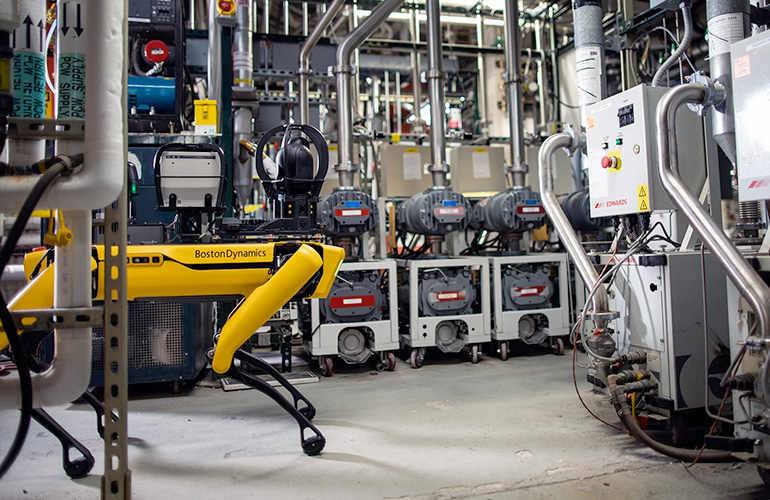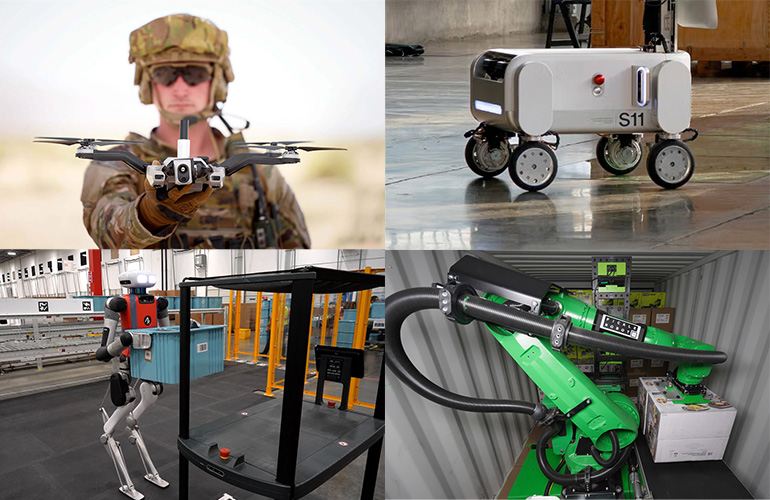Since its commercial release in 2020, Boston Dynamics Inc.’s Spot robot has evolved to become more capable at facility inspection tasks. In that time, the quadruped robot as achieved greater autonomy and an ever-growing set of sensor payloads.
In 2022, Waltham, Mass.-based Boston Dynamics won an RBR50 innovation award for its release of Spot Enterprise.
The company recently upgraded the yellow, four-legged robot with several new features in its latest Spot operating system release. Boston Dynamics continues to deploy the robot into new industrial applications, and it said this latest software release supports growing market demand.
Spot now more nimble, perceptive than ever
The mobile platform is designed for missions such as the inspection of industrial facilities. Spot’s nimbleness and mobility over uneven surfaces make it a viable option for automated tasks including regular patrols around a facility.
Boston Dynamics said the new software release enhances the ability of Spot to detect and avoid obstacles while on a mission.
The legged robot can also be equipped with a sensor payload that can detect leaks, proactively check equipment health, and log the results or raise alerts when a threshold is breached.
New, fully integrated sensor options enhance Spot’s capabilities. Using a Spot-mounted Fluke SV600, operators can collect acoustic vibration data. By automating such predictive maintenance, the mobile robot can help facilities avoid unplanned downtime and reduce costly inefficiencies, said Boston Dynamics.
Orbit software supports digital twins, issue resolution
Creating and maintaining a digital twin of the facility is now possible with Spot through laser-scanning integration with Orbit, Boston Dynamics’ fleet management software. The new feature in Spot enables operators to plan reality-capture missions similar to how they would plan inspection missions.
Using a Spot-mounted Leica BLK ARC laser scanning payload, data from a mission is uploaded and ready to process in a user’s preferred digital twin software.
The Orbit interface has a new look and feel. Alerts are now easier to identify and triage, shortening the cycle for resolution, Boston Dynamics said. Now, all active alerts are displayed in the Site Map until they are reviewed and cleared. Details about each inspection are available in a single click, the company added.
Operators can now have the confidence that issues raised by Spot can be resolved quickly and cleared from the alert queue as a maintenance workflow is initiated, it said.
Spot is better able to navigate around obstacles
Industrial facilities such as power stations, factories, and warehouses are dynamic and complex. Spot can track moving objects like tuggers, fork trucks, and people and avoid these obstacles.
In addition, Spot can now also detect and avoid common hazards such as carts, wires, and ladders, according to Boston Dynamics.
The Spot Core I/O improves the visual semantic context of the items that Spot encounters and enables the robot to plan paths around obstacles to complete its mission. The robot can now perceive a wider area so it can identify more options for alternate paths when it encounters larger obstacles.
Multi-docking has been automated with Boston Dynamics’ latest release. For long missions, Spot can recharge at the nearest dock along its path before continuing on its mission. This enables large sites to extend the range of autonomous missions and maximize Spot’s inspection time since the robot is no longer confined to one docking location.
Tablet Controller Pro gets an ergonomic makeover
Boston Dynamics has also improved the ergonomic features of the Spot controller tablet. A new set of joysticks incorporates a lightweight design, larger buttons, and additional controls.
The company said it has also extended the system’s battery life, Wi-Fi, and radio range. An operator can also now mirror the tablet’s screen to nearby monitors, providing a view for other staffers.
Boston Dynamics provided all the details of its update in the Spot software release notes.

Spot can carry different sensor payloads for facilities inspections. Source: Boston Dynamics
Field, legged robot market expected to grow
The global market for inspection robots could expand by $5.7 billion between 2024 and 2028 at a compound annual growth rate (CAGR) of 19.86%, according to Technavio. The research firm attributed that growth to adoption of mobile robots and cloud-based systems that allow for remote and real-time monitoring.
Similarly, Business Research Insights predicted that the global market for legged robots could grow from $0.59 billion in 2023 to $1.99 billion by 2032 at a CAGR of 14.3%. It cited the increasing integration of machine learning and AI along with interest in remotely accessing facility data.
Editor’s note: A panel at RoboBusiness 2024, which will be on Oct. 16 and 17 in Santa Clara, Calif., will discuss the challenges of designing outdoor robotics.

 2 months ago
33
2 months ago
33









 English (US) ·
English (US) ·